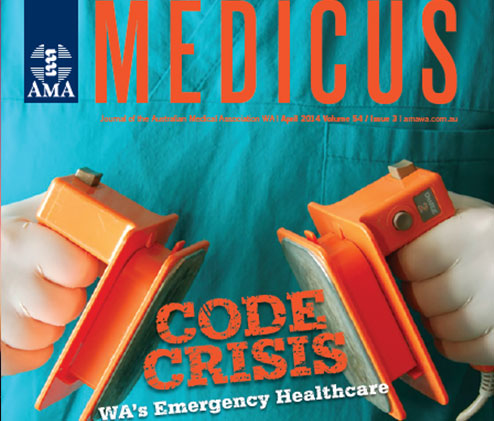

Blog

Flashback Friday: Code Crisis – April 2014
Tuesday September 28, 2021
I first used the term ‘demand tsunami’ for a five-minute presentation to a health innovation meeting in Sydney in 2002. It was apparent that over the first two decades of the 21st century, demand for emergency and acute health services would unrelentingly increase across Australia.
As acute care systems became overloaded, emergency department overcrowding and its corrosive effects would increasingly impact the quality of emergency and acute care.
It is now generally accepted that ED overcrowding, caused by delays to definitive care, results in measurable harm to patients requiring admission to hospital.
The Western Australian Government and successive WA Health administrations should be recognised for acknowledging the harm associated with ED overcrowding and for funding innovations with the express aims of reducing delays to definitive inpatient care.
Some good work has been done to improve patient flow in WA hospitals under the 4 Hour Rule banner. Hospital mortality appears to have fallen. A generation of clinicians has been exposed to modern health innovation methods. However, not enough has been done to control demand upstream of our acute care system.
A greater focus is needed on implementing the models of care that are known to keep chronically unwell patients out of hospital and on investment in the funding approaches and informationsharing platforms that these models of care rely upon
The absence of investment in disease management upstream saw some predictable and negative effects of improved patient flow and shorter queuing times at Perth’s EDs. The most obvious was the stimulation of demand for acute care.
“Applying suction to healthcare demand” — to quote a colleague — saw a rapid growth of emergency activity associated with the 4 Hour Rule innovations, and could not be explained by seasonal or demographic factors.
Speed Medicine
The jump in demand and increased pressure to exit a patient from an ED or to discharge patients from high turnover acute admitting units in order to meet performance targets saw ‘speed medicine’ emerge as a new clinical ‘art’.
I define speed medicine as clinical care where the objective of care is to transition a patient as rapidly as possible to the next clinician, irrespective of the appropriateness of the transition, the level of completion of assessment and management, or with proper regard to patient choice.
Handing over care between several clinicians in a short space of time is inefficient. Information is lost at every handover, increasing the risk of adverse events. In a speed medicine environment, clinicians have less time to consider what the patient really wants from the acute care environment.
Not all patients want the full symphony available in our tertiary hospitals and our best clinicians’ virtuoso performances are then wasted. The consequences of speed medicine include lower quality assessment of the whole patient and an increase in measures of care failure, such as re-attendance, re-admission rates and adverse events.
As a system, we are yet to define or implement the information systems and care systems needed to reduce the risks associated with high turnover care nor effective incentives to discourage the practice of speed medicine.
Choosing the right metrics
In attempting to address the issue of incentives, the current framing of incentives via the National Emergency Access Targets appears to be resulting in less emphasis on several fundamental indicators of care quality. If we accept that the principal objective of the acute care system is to make sick or injured people better; and in conjunction with the sub-acute and community sectors, rehabilitate and keep people well, health system managers now appear less interested in metrics that allow measurement of these outcomes than in measures of throughput and episode of care ‘price’.
If acute care is effective, it should allow people to experience less overall hospitalisation over the course of a year rather than more. A simple metric that assists measurement of acute care ‘value’ rather than episode of care ‘price’ is whole-of-year total hospital resource use – where all the days and costs of all episodes of hospitalbased care are added up per year for a patient rather than for a single episode of care. Constantly focusing on reducing episode length of stay does not necessarily reduce whole-of-year hospital resource use.
As just one of many examples, it is arguable that patients with biliary colic consume more hospital resources in 2014 than they did 20 years ago, despite dramatic reductions in length
of stay for individual episodes of care. Rather than the offending organ being removed at first hospital attendance, many patients suffer recurrent attacks on waiting lists for surgical clinics or elective surgery, resulting in repeated visits to EDs and admissions for complications. Such waste and unnecessary suffering could be avoided by operating on patients who would benefit from surgery at first attendance.
Filtering the noise
The focus on single episodes of care has resulted in another unintended problem – noise in the data that makes evaluation of the effectiveness of our acute care policies and innovations very difficult. The keystone of patient flow through the acute care system and the only predictor needed to model ED overcrowding is the level of mismatch between the demand for and availability of ‘overnight’ acute hospital beds.
Yet we rarely measure the effectiveness of our innovations and substitution strategies in relation to overnight bed demand reductions or the increasing availability of overnight beds.
Alternative endpoints have consistently resulted in overstatement of benefit from innovations. A hospital in the home ‘bed’ is not a one-to-one substitute for an overnight acute care
bed.
Less talk, more action on disease management upstream.
This leads to the elephant in the room. Western Australia has not consistently invested in the funding approaches, care models and the information sharing platforms to consistently keep patients with chronic disease out of hospital.
Clinical information sharing is an essential element of all disease management models of care. WA Health owns some useful parts of the disease management information system jigsaw
but has no strategy to acquire other essential components. While the federal and state governments find it convenient to continue their perennial blame game, rather than work cooperatively to iron out the funding disincentives that inhibit the implementation of effective disease management models, we will continue to waste much of our acute care resources
picking up the pieces.
In conclusion, WA can be proud of some genuine improvements in our acute care system over recent times.
However there is much work to be done, most of it upstream of our EDs, if we wish to hold our gains and continue to improve the outcomes for patients and the lot of staff working in EDs as the demand tsunami continues to buffet our acute care system over the next 10 years.

Professor Peter Sprivulis is an Emergency Physician at Fremantle Hospital and a Clinical Associate Professor of Emergency Medicine at the University of Western Australia.

